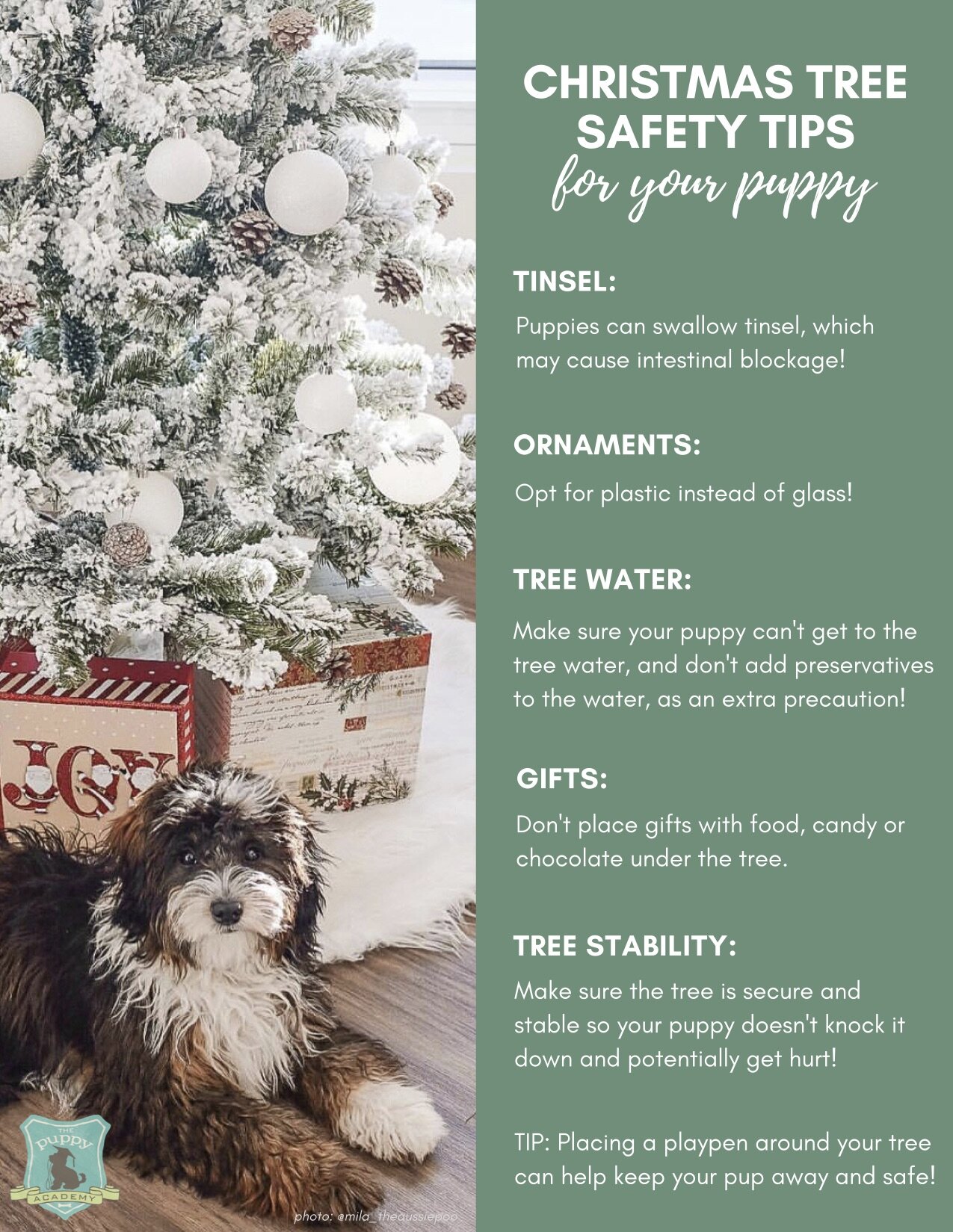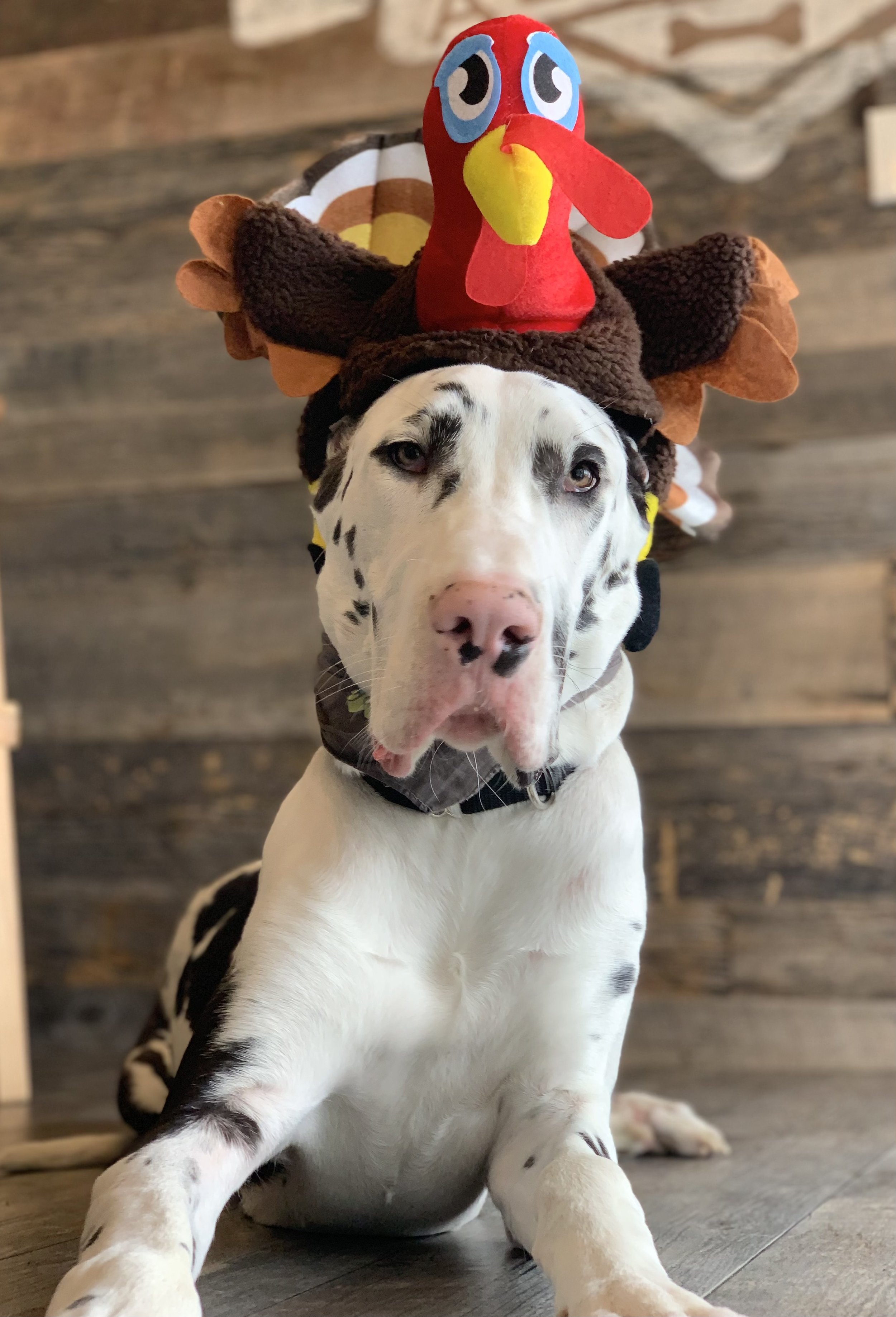‘Tis the time for cheer and puppies! During the holidays, all the excitement can be very overwhelming and distracting — especially for our pups! New decorations, new activities and new people can mean more opportunities to get into a little trouble. Keep these puppy Christmas tips handy to ensure your puppy is safe and ready for the holidays along with family get-togethers!
The holidays are here and many of us have already decorated our homes! While you’re in the midst of enjoying lights, ornaments, and flowers, you want to make sure you are also considering “is my home safe for my puppy?” Whether you already have a puppy or are expecting one this Christmas, it’s important to puppy-proof your Christmas Tree and your home to ensure that they’ll be and safe.
We know this time of year can be stressful enough and the last thing you want to do is worry about your puppy getting hurt, so we’ve out together this list for our students and their parents at our puppy school and wanted to share with you too!
“People tend to relax on their normal “rules” around the holidays. Remember to keep up with your pup’s training as much as possible, pay close attention to them (or put them in their crate when you can’t), and don’t expect them to be perfect! They’re still puppies and learning each day — there will be some mistakes!”
Christmas Tree Safety
A new big shiny tree in the home is sure to grab your pup’s interest! There’s ways to modify your tree decorating and keep things secure to ensure your pup’s safety. Save this Christmas Tree Safety Tips cheat sheet for quick reference!
Holiday Plants & Flowers
Many puppy and dog owners alike have often heard at some point that Poinsettias are poisonous to our furry friends. And although they do contain a white milky sap, they are only mildly toxic. Whew! Here are the more serious culprits that you should be looking out for: Mistletoe, Holly berries, Rosemary -- and make sure to be aware of any poisoning-type symptoms!
Luckily, many of us hang up these flowers like Mistletoe and Holly but sometimes, they can be found in other decorations such as in a table centerpiece or on food if it’s Rosemary. In those situations, be mindful that your puppy won’t have access to decorations and that food isn’t left around where they can get into it!
Christmas Lights
One of the most beautiful parts of Christmas decorations is the many twinkling lights! But to curious pups, they can seem like a fun chew toy. Light cords are like magnets for young puppies, especially if they’re going through a teething phase. Lights can be very harmful as they can cause electrical burns inside your puppy’s mouth, or smaller light bulbs can be easily swallowed, which can cause intestinal blockage. Make sure no loose cords are left on the ground or uncovered and secure them to your tree or bring them off the ground so your puppy can’t reach them. Utilize playpens and puppy gates your puppy can’t access them when if they’re ever unsupervised.
“Put a playpen around the tree so your pup can’t get to it and all those tempting, shiny ornaments! ”
Food and Drinks
With any holiday, food and drinks will be plentiful! This is a great time for puppies to get into something they shouldn’t (ie. the Christmas cookies or chocolate sweets on the coffee table!) and get sick. A super simple way to avoid your puppy from snacking on cookies or other holiday treats is to keep them out of reach and whenever possible, keep your puppy away from where they are. If you can crate your puppy in another room during eating time, even better. If that’s not possible, remind your guests to be cognizant of where they place their drinks or food plates so no accidents happen, and practice a good Recall with your pup so they know to come to you anytime you call them! Not there yet with your puppy’s training? Keep them on harness and leash to be able to get better control with them, and if you’re ready for that good-mannered pup, join us in our Online School!
Prep Your Guests
Planning on hosting? Some of your guests may not know that you have a new puppy in the home so a quick reminder is all you need to make sure your puppy is safe! Let your guests know how you want them to interact with your puppy, not to feed the puppy any human food,, and to make sure they shut the door when coming and going from your home. Another good tip to follow is prepping a puppy “safe zone” beforehand. All the attention, sounds, smells and tightened energy can be overwhelming for a young puppy! Pick a spot that’s quiet and away from all the excitement (ie. their crate in a quiet area of the house) so your puppy can go to get some rest and feel comfortable and safe. A big plus side to having a place just for your puppy is the peace of mind that they are safe and you can go about your night and enjoy the festivities!
“Toss used wrapping paper directly into the trash when opening gifts. Puppies loooove to sink their teeth into those crinkled paper balls, which can be bad for them to ingest.”
Have a Backup Plan
Overall, the most important takeaway is: PREVENTION IS KEY! By preparing and properly puppy-proofing your home beforehand, you can help keep your puppy safe throughout the holidays and avoid a stressful last minute vet visit! But like all good Christmas pet safety plans, having back up resources are always a good idea. Before you get into the throws of setting up to host a big Christmas get together, look into some local 24/7 emergency pet clinics and pet poison hotlines. Keep these numbers in your phone contacts or someplace handy in the event that you need to place a call for help for your puppy.
Have more questions about Christmas safety and tips for your puppy? Ask our trainers LIVE every Wednesday at 1 pm PT on our Instagram @thepuppyacademy during the Ask A Puppy Trainer Show! All replays are posted afterward, and you can catch up on our last ones on our YouTube channel!
Become a Puppy Academy VIP (Very Important Puppy) to get our latest puppy training tips direct to your inbox, for free, each week!
Merry Christmas and Happy Holidays from all of us at The Puppy Academy!
Check out these other blogs on puppy training:
I Got a Puppy Over the Holidays! Now What?!










